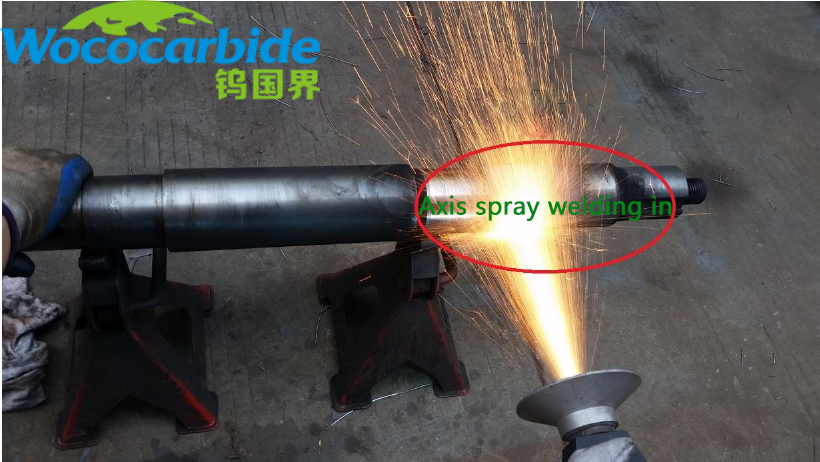

Plastic spraying is a technique for creating barrier and barrier coatings. Plastic refers to a high molecular polymer material that is in a glass state at room temperature and can be used as a thermal spray material. With the rapid development of the plastics industry, various products with strong corrosion resistance and good wear resistance have been widely developed and applied. This kind of plastic powder is applied to the metal surface by means of spraying technology, which can play a good protective effect. Some thermoplastic polymers such as nylon (Nylon), ethylene-vinyl acetate copolymer (EVA) and some thermosetting polymers such as polyester epoxy resin have been successfully developed and applied. Thermal spraying plastic materials are mainly used for the protection of metal structures in corrosive environments and the friction reduction and lubrication of material surfaces. Spraying plastics on metal and non-metal surfaces can beautify the appearance and corrosion resistance. Especially through modification, some thermoplastic polymers can show good mechanical properties and chemical properties in the high-humidity environment of immersion in salt spray; the ester-like smooth surface formed by spraying can provide good dry resistance and water washability, enhancing Wear resistance in mud and running water; some thermosetting polymers show good adhesion and high temperature resistance.

All plastic materials for thermal spraying are in powder form, and the particle size is mainly 80 meshes to 100 meshes. The shape of the plastic powder material should be spherical or nearly spherical, so that the powder can be fed smoothly during the spraying process.
Compared with other spray materials, its outstanding characteristics are as follows.
(1) Very small density. The density of plastic is generally between 1 and 2, which is 4 to 8 times smaller than that of steel materials. As a coating material, its consumption is less than that of metal materials.
(2) Good chemical stability. Most plastics have good corrosion resistance to acids, alkalis and organic solvents, especially the polytetrafluoroethylene plastic known as "the king of plastics", in addition to being able to interact with molten alkali metals potassium, sodium, lithium and trifluoride In addition to chlorine, oxygen trifluoride at high temperature, and fluorine at high flow rate, it can resist the corrosion of almost all chemical media (including concentrated nitric acid and aqua regia), and the long-term working temperature can reach 230 ° C ~ 260 ° C.
(3) Good wear resistance, friction reduction, self-lubrication, electrical insulation, shock absorption, sound absorption and impact resistance. Many engineering plastics, such as polyoxymethylene, chlorinated polyether, polyamide (nylon), polytetrafluoroethylene, etc., have low friction coefficient and self-lubricating properties, which naturally enhance their wear resistance. If various fillers are added, the friction coefficient can be further reduced, the wear resistance can be improved, and the load carrying capacity can be improved. Almost all plastics have excellent electrical insulation and arc resistance, and their performance is comparable to that of insulating materials such as ceramics and rubber.
In addition, compared with metal materials, plastics also have many disadvantages. First, its strength is far less than that of most metal materials; its heat resistance is also low, generally not exceeding 250°C. Plastics also have different degrees of hygroscopicity, with large expansion and contraction deformation; the melting temperature range of plastics is not wide, generally tens to more than 100 degrees Celsius. It will decompose or carbonize if it exceeds a certain temperature range. Aging is also a major disadvantage of plastics, especially under strong UV exposure and at higher temperatures. Some of these shortcomings of plastics can be overcome or improved by adding appropriate additives. For example: adding some metal powders can improve its bearing capacity, thermal conductivity, wear resistance and light reflection and aging resistance; adding various oxides can improve its hardness, bearing capacity and wear resistance; adding metal sulfides can improve Its self-lubrication and wear resistance; adding natural minerals can improve its self-lubrication, thermal conductivity, heat resistance and electrical insulation.
Plastic powder spraying usually adopts flame spraying technology, and the key problem is the control of the heating degree of plastic powder. Burning, over-melting or poor melting of the plastic powder will affect the quality and bond strength of the spray coating.
In order to achieve the above purpose, the heating flame of plastic spraying generally adopts compressed air-propane flame or oxygen-propane flame. And a curtain formed with compressed air is added between the heating flame and the plastic powder to protect and control the heating degree of the plastic powder.
Plastics for thermal spraying can be roughly divided into two categories: thermoplastics and thermosetting plastics. The properties of the two commonly used plastic powders are introduced below.
1. Thermoplastic powder
Thermoplastic molecular chains are straight chains or branched chains. Many molecular chains gather together by intermolecular forces to soften and melt after being heated. After cooling, they can be restored to their original shape. After repeated repetitions, their chemical structure is basically unchanged. Generally thermoplastics have excellent chemical resistance, toughness and flexural properties. Thermoplastic powders include polyethylene, polypropylene, polyamide (nylon), polyimide, ABS plastic polychloroether, polyphenylene ether, polyphenylene ester, polyoxymethylene, and fluoroplastics.
2. Thermosetting plastic powder
Thermosetting plastic powder is characterized by using certain prepolymer resins with a lower degree of polymerization, under a certain temperature or adding a curing agent, to solidify into a hard final product that cannot be melted or melted again. When the temperature is raised again, the product can only be decomposed and cannot be softened. Thermosetting plastics have low molecular weight, so they have good leveling and wetting properties, so they can adhere well to the surface of the workpiece and have good decorative properties. Thermosetting plastic powders commonly used in flame spraying include epoxy epoxy polyester and polyester powder.
Hot information

